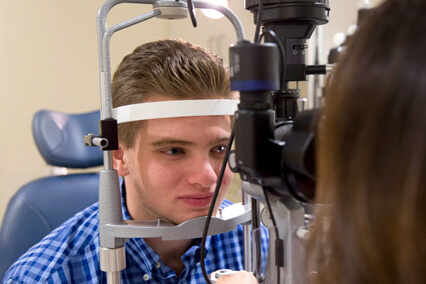Corneal Cross Linking
Children’s Mercy was the first pediatric center in the nation to offer corneal cross linking procedures for children and teens with keratoconus, an eye condition that often begins in adolescence and gets progressively worse.
What is keratoconus?
Keratoconus is a condition in which the cornea—the clear layer of tissue on the front of the eye—begins to thin out or bulge into a cone shape. Symptoms include blurred vision, sensitivity to light, and rapidly worsening eyesight.
Most of the time, symptoms begin during puberty or young adulthood. Sometimes, they can occur earlier in childhood too.
The condition is also much more prevalent in people with developmental disabilities such as Down syndrome than in the general population.
Treatment options
Until recently, the only treatment options for keratoconus were corrective lenses (glasses or contact lenses), which often needed to be changed frequently due to vision changes. Eventually, a corneal transplant was needed when corrective lenses were no longer working.
With the discovery of corneal cross linking treatment, people with early-stage keratoconus can stop the progression of the disease and potentially avoid the need for a corneal transplant.
Meet the expert
Dr. Erin Stahl performs the corneal cross linking procedure at Children's Mercy. Dr. Stahl is dual fellowship trained in pediatric ophthalmology and in corneal and refractive surgery. This makes her uniquely suited to treat children with keratoconus and other corneal disorders.
Families with a diagnosis of keratoconus can make an appointment directly with Dr. Stahl at our Children's Mercy Broadway location by calling (816) 960-8000, or your primary care provider or eye doctor can refer you to the clinic using our Provider Portal.
How does corneal cross linking work?
Corneal cross linking (CXL) treatment involves a combination of vitamin B2 drops and ultraviolet light that are applied to the eye over a carefully-timed period.
Together, the drops and the light create new collagen cross links and strengthen the cornea. In most cases, the ophthalmologist removes the epithelium—the outermost layer of the cornea—to allow the drops to fully penetrate the cornea.
The procedure takes about one hour to treat one eye. If both eyes need treatment, each eye is done in a separate, spaced procedure.
Specialized care for kids
In adults, corneal cross linking is often performed with only local anesthesia for the eye. However, it can be extremely difficult for children or people with developmental disabilities to lie still for the procedure.
That's why Children’s Mercy offers the option of general anesthesia for CXL. When you choose Children’s Mercy for your CXL treatment, your child will have a care team who specializes in working with children and young adults. Everyone from the anesthesiologists to the nursing staff are experts in caring for kids and teens.
Read more about pediatric anesthesia at Children’s Mercy.
What to expect at your appointment
On your first visit, there will be many tests that involve taking specialized pictures of the eye. The tests are not painful and help the doctor assess the stage of keratoconus progression.
After testing, your child's eyes will be dilated and the doctor will perform a full exam. Afterwards, Dr. Stahl will talk with your family about keratoconus and whether your child is a candidate for cross linking treatment.
Corneal cross linking: Noah's story
Noah DeFerraris has a rare eye condition called keratoconus. His vision was failing, then he found Erin Stahl, MD, Children’s Mercy ophthalmologist. Dr. Stahl recommended a procedure recently approved by the FDA called corneal cross linking, and now Noah is seeing 20/20!

